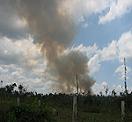Results from the plenaries
Posted on December 30, 2011
Fires in Western Amazonia: The Effects of Climatic, Social, Demographic, and Land Use Changes on Fire Incidence and Fire Hazard
19-22 August 2011
Presentation of the results of the conference to authorities and members of the civil society in a session opened to the public.
Plenary 1: The role of changes in patterns and scales of land use and the incidente of escaped fires in Western Amazonia
- Fire patterns in Western Amazonia are contrasting in terms of sources of ignition and land covers burned. The identified trajectory consists o fan increase in escaped fires derived from agricultural Management and assisted by migration and occupation processes. The expansion of crops oriented towards markets outside Amazonia might be generating new fire trajectories.
- Although these patterns are contrasting, it is necessary to evaluate the conditions under which the future incidence of fires might confluence to the processes observed in other areas of Amazonia.
- The impacts of escaped fires in Amazonia have been evaluated predominantly on forest ecosystems and resulting changes on biodiversity and carbon. Spatial differences in fire patterns require an integral evaluation of the impacts on social-ecological systems.
- Escaped fires have been conceived traditional as a consequence of management practices. However, it is important to consider that fires might modify management practices and therefore it is important to evaluate resilience strategies developed by different actors.
Plenary two: Relationships between changes in land property regimes, migration patterns, and urbanization and escaped fires in Western Amazonia
- There are some experiences on reducing fire use in Acre through integrated policies and programs that might have implications in other Amazonian regions.
- Most Amazonian ecosystems are not adapted to fire incidence but fire has been used historically as a central practice for fire management. The mitigation of escaped fires should consider social and ecological implications of implementing strategies of eliminating fire from agricultural management vs. to improve fire use practices.
- Strategies for mitigating escaped fires require to develop governing systems at different scales and implementing centralized systems of fire monitoring and land use change.
- Market mechanisms for reducing carbon emissions such as REDD, could contribute reducing forest conversion and therefore sources of ignitions. However net emissions from escaped fires are highly variable and therefore REDD should be consider as part of a broader strategy.
- Land tenure patterns in Amazonia probably play a central role on the occurrence of forest fires but their relationship is not completely understood. It is important to reduce sources of uncertainty and conflict as well as consolidate information on that regard.
- The great heterogeneity in demographic, economic and cultural characteristics, as well as new forms of residence and occupation require to elaborate specific solutions , appropriate for the conditions of different communities.
Plenary three: The role of regional climate variability and climate change on the incidence and risk of fires.
- The works presented in the conference show a consensus about the increase in the occurrence of extreme climatic events during the last years. There is also an agreement about a possible increase of these extreme events in the near future.
- It is prioritary to understand how changes in land use can accentuate the effects of climatic variability
- The last extreme dry seasons were related to el Niño events followed by warmer anomalous temperatures in the North Atlantic. Therefore, Ocean monitoring is important for forecasting extreme dry seasons.
- It is important to strengthen and expand the network of environmental monitoring stations in order to improve the validation of hydrologic and climatic models in Western Amazonia and therefore improve predictions in the medium and long term.
Plenary four: The role of fires in the integrity of biodiversity and the provision of ecosystem products and services
- Our understanding of fire impacts on biodiversity is very limited, because of the limited number of studies on taxonomic groups, the poor spatial coverage of sampling effort, and the potential for high levels of spatial variation.
- Where fires occur, existing studies demonstrate that they have significant and long lasting impacts on biodiversity (birds, vegetation).
- Fires and smoke have many social and economic consequences, including health tourism, etc – we need to understand the full economic and social costs, including the impact on NTFPs (foods, construction material, medicines, etc).
- It is important to consider the value of intact (unburned) forests for their ecosystem services in the western Amazon, including their role as fire breaks in fire-prone landscapes; the value of intact forests for hydrological cycle and aquatic integrity; the value of their carbon stocks.
- It is important to establish to what extent could fires negate emissions reductions from any REDD scheme.
